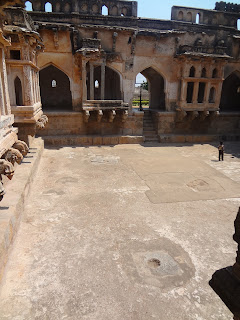Well, our last day ended a bit anti-climactically: Abby and I were told to meet the van at 12:30 today for afternoon psychiatry clinic, but there was nobody there. We waited and waited, and eventually gave up, so now we have the afternoon unexpectedly free. I thought I’d take the opportunity to write my final blog post of the rotation (although I may write some travel-related posts next week if I have the opportunity).
Abby described the beginning of our week, with the autism survey and health education talk. Below is a picture of the talk, which took place in a village schoolhouse:

On Tuesday, we had eye clinic. Cataracts are a big problem in India, and the majority of the patients were either pre- or post-op cataract surgery patients. The Mugalur clinic has a program that provides cataract surgery, including one night as an inpatient, pre- and post-op visits, and medications, all for 500 rupees (about $10). The same surgery would cost many times more in a hospital (although still much less than in the US, I’m sure), and patients come from far away to take advantage of the deal. It is a wonderful thing for them, since many have little or no vision before the surgery, and most are elderly rural villagers without a reliable source of income. It’s a busy service; I believe the doctor said they do about 10-20 surgeries every Monday.
Yesterday I spent the day in dermatology clinic, and Abby was in gyn-onc clinic (really mostly gynecology, not oncology, according to her). Dermatology clinic was interesting, especially since I hadn’t had a chance to do it in the hospital as most of the others did. We saw pityriasis alba (pale patches on the faces of dark-skinned children), chemical vitiligo caused by hair dye, palmar-plantar dermatosis, polymorphous light eruption (caused by sun exposure – plenty of that in India), as well as common things like acne, seborrheic keratosis, psoriasis, and allergic reactions. One lady had a reaction to the kumkum powder used in her forehead bindi; the doctor suggested other kinds of powder she could use instead. The doctor also told me about a plant called parthenium, or congress grass. Apparently, this is a weed native to North America that was inadvertently introduced to India in a shipment of wheat, and has since become widespread. He said that Indians are very sensitive to it and it causes all kinds of skin rashes, as well as hay fever and asthma. He told me it is called congress grass because the US Congress approved the wheat shipment, although something I read says it is because it grows in clusters. Who knows.
Last night the five of us made the trip into downtown Bangalore to see UB City (a fancy shopping mall full of designer stores – Versace, Jimmy Choo, Louis Vuitton, etc, as well as the ritzy Sky Bar), and to have dinner at the Biere Club, Bangalore’s first brewpub (established in 2011!) We had a delicious shared platter of middle eastern food, and of course a sampling of the beer!
Well, that is it for our rotation (and medical school – crazy!) It has been a good experience in spite of the occasional frustration, and I think we’re all glad we came. I had the chance to see things (dengue hemorrhagic fever, lots of TB, Indian rural health care) that I will probably never see at home, and to experience another culture and health care system very different from my own. We got to travel to interesting places and experience life in the center of India’s technology boom.
Tomorrow morning I will catch a plane for Delhi to start the final leg of my India trip. I will be joining a group tour of North India, featuring Delhi, Agra, Jaipur, and Ranthambore National Park. If I have internet, I will continue to post to update everyone of my travels!
Namaskara!
Libby












































